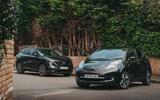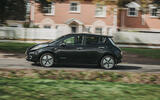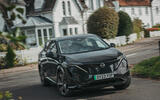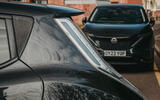I still can’t quite understand what Nissan was thinking over the past decade.
I know the Qashqai and Juke were wildly successful and there was a second-generation Leaf but, to me, it seemed like Nissan was at the forefront of electric car making, and then just lost interest.
The Mk1 Leaf you see pictured has been lent to me by ex-car journo Ross Pinnock. He would be the first to admit that this car isn’t his pride and joy, but it has held up remarkably well. Everything inside is intact, it all works and there are no nasty noises.
Sure, range is down from a (doubtful) official 124 miles when new to around 65 miles now. But when you’re just using it for around town, have off-street charging and are only paying around 5p per mile for electricity, you’re laughing.
There’s a definite lineage between these electric Nissans: the Ariya just looks and feels like it has improved on the Leaf recipe.
First off, the Leaf's oddball drive selector, although kind of cool in a way that’s reminiscent of those translucent-backed early iMacs, has thankfully been replaced with a more conventional gear slider.

The Leaf feels weirdly tall to drive, and the Ariya, despite being taller, is much more reassured. The Leaf is so bottom-heavy that it sort of sways around in the wind, like one of those Wacky Waving Inflatable Arm-Flailing Tube Men that are employed by American used car dealers.
The foot-operated parking brake in the Leaf is also a blast from the past that I don’t miss in the Ariya. I don’t think I’d used one of those since I had a W140-generation Mercedes-Benz S-Class.
I was pretty surprised by how good the Leaf was to drive overall, though. It still feels pretty nippy and, like with the Ariya, the driving modes really do make a big difference.
Funnily enough, one place where Nissan has gone backwards in this regard is the selection of said modes.
Nine times out of 10 I, like many EV drivers, select Eco. Maximum range is the goal here. The Leaf allows you to select Eco on a button and it stays like that when you get in it the next time, whereas in the Ariya you need to select Eco each and every time.

The fact that the Area has a 22kW AC on-board charger and the Leaf makes do with a 6.6kW one is a bit of a moot point because of the age gap; you would have been extremely lucky to find such a strong charger a decade ago.
But Nissan has learned from the Leaf's charging in two important ways. For one, the Ariya uses the now standard CCS plug, rather than the Chademo one that was favoured by the Japanese in the early days. And two, it doesn’t have its charging port flap at the front. I find such things incredibly irritating, because only heathens park nose-first, especially in public places.
Where Nissan has moved the game on most of all, though, is the interior. The Leaf's has worn well, but even a decade ago it was considered a bit downmarket.
The plastics look and feel cheap and the doors sound very tinny when closed. With the Ariya, multiple people have asked me if it's really a Nissan.
The fit and finish is above the industry standard, the heated and cooled leather seats are brilliant for long journeys and the blue suede interior is to die for. The touchscreen infotainment software is just okay, but realistically, as long as the hardware is okay too (which it is), then everything is groovy, because I just use Apple CarPlay any way.

Despite only being 100mm or so wider than the Leaf inside, the Ariya feels night-and-day different in terms of spaciousness, mainly because the centre console and dashboard don’t connect any more.
Mind you, doing my research on the Leaf pulled into sharp focus just how expensive this Ariya is. The original Leaf in today’s money would cost from around £33,000, whereas my Ariya, which isn’t even in the top spec, is more like £55,000.
Has the Ariya been worth the 11 year wait? Honestly, I think it has. Despite a lukewarm reception and a few niggly ride concerns, it has what it takes to worm its way onto the shopping lists of eco-conscious families. With a few improvements to its ride and range and a bit of a price drop, it could even get towards the top. Just don’t leave us waiting for another 11 years, Nissan.



























Join the debate
Add your comment
How do you come to the conclusion that only heathens park front first? Do you jhave more space, usually, driving into or out of a parking space? So why would you by default reverse into the far more constrained place?
When doing a comparision on price the 55k example is a bit pointless, the base Ariya starts from 39.6k a fair bit more than the Leaf but then it's in a different sector.